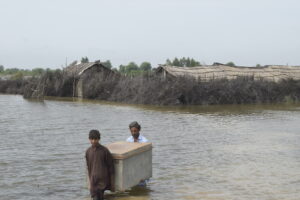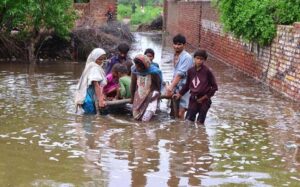“It was water all around. People were struggling for their safety in hope of some help. But, what we could find, was the ceaseless downpour compounding our problem,” recalled a daily wage labourer who could barely save his family from the flood waters.
Shah Meer Jalalani’s heart wrenched as he saw his mud house flattened by gushing torrents from Suleman Mountain Range after torrential rains hit Pakistan’s Rajanpur district in the South Punjab region, inflicting loss to human lives and property.
He could only rush to take refuge at a nearby 11 feet high knoll along with his family members leaving behind his valuables inundated by flood in his village Basti Sultan Nagar, a tribal area of Tehsil Jampur.
His heart ached on seeing loss to his lifelong earning but saving his wife, his children and elderly parents was a sigh of relief for him. He had never thought to endure living on a knoll helplessly when water was all around with people running for their lives.
“It was water all around. People were struggling for their safety in hope of some help. But, what we could find, was the ceaseless downpour compounding our problem,” recalled Shah Meer whose only earning was daily labour work.
“Water was high enough to touch the mound top but there was space we could sit,” Shah Meer. “We spent two days without food when a rescuers’ boat found us, provided some edibles and took us to nearby Jampur-Harrand roadside dry place where we were also provided a tent to live.”

Millions left homeless
The flood triggered by torrential monsoon rains over Suleman Mountain Range spared none, sweeping everything in its way submerging villages in Rajanpur and Dera Ghazi Khan districts besides a thriving city Fazalpur. It ravaged the lives of poor and white-collar communities alike.
Rehmatullah Lashari, a local landlord of Basti Nawab, witnessed his riches turning into rags including five tube wells powered by solar system with a cost of 15 million Pakistani rupees to water his farmland.
“My house and near ripe cotton crop has been swept away by flood. I cannot sow wheat on this soil due to water. Everything I had is gone now,” he said amidst fears that he could not be able to cultivate his land for months.
The huge catastrophe has left millions homeless, compelling families to survive along roadsides and at relief camps, solely depending on aid for food and other needs.
Aziz Ahmed Machi, a tailor from Rojhan Mazari met the same fate. The bread winner of 13-member family lost his house along with dowry of his daughter.
Same happened with an elderly widow Sahab Bibi in mauza Rakh Azmat Wala whose a modest dwelling was wiped away during this catastrophe.
“We were living happily in our two-room mud brick house but floods turned it all upside down sweeping dowry of my daughter,” Sahab Bibi said.
Monsoon hill torrents
Amidst the visits of the Pakistan president, the prime minister and the federal and provincial ministers and politicians and VIPs of every ilk, Pakistan’s national disaster management authority (NDMA) together with army-men and local authorities have been busy providing relief goods to the affected people.
According to OCHA Humanitarian Advisory Team’s (HAT) situation overview citing National Disaster Management Authority (NDMA) report, floods affected over 33 million people across the country and around 4,70,000 forced to live in collective sites and many more displaced being hosted by other households.
Many in Pakistan think on the same line. They feel that building more dams and deepening existing river beds that are rising due to silting is a panacea. This can be complemented with farmers growing climate resistant crops to cope with the challenge, they say.
“Hill torrents often cause trouble during monsoon season but not to the huge extent witnessed this time in Rajanpur and DG Khan districts,” said a former Director General of Pakistan’s Intelligence Bureau, Sardar Hassan Akhtar Khan Gorchani.
The deluge had ravaged his crops in Lalgarh village of Tehsil Jampur as the rain water overflowed from nullahs and tributaries flowing through the area.
Vanishing community action
Seeing the destruction of flood, he opines that de-silting the route of hill torrents and expanding their width besides building dams will be helpful to deal with future floods that could be as or even more menacing due to climate change.
“Once 50-60 feet wide and enough deep, hill torrents routes now portray some ordinary nullahs after continuous silting and encroachment had shrunk their bed,” he remarked. At the time, there was community action to prevent a deluge from becoming too big to handle.
Narrating a pre-partition practice during British Raj, the former civil servant who is now dabbling in politics, explained that farmers used to contribute in de-silting activities by digging soil and widening the bed. “These activities used to prove as a safeguard against torrents absorbing maximum flow of rain water.”
But, in recent decades this practice vanished with bed level coming up and now even moderate rain exposes the adjacent area to flood, he said, arguing for speeding up construction of the ‘Maranj dam’.
Infrastructure, clearly is seen as a supplement for community actions of yore. The cost of the first phase of the Maranj dam project Rs 350 million and a sum of Rs 255 million was allocated in 2020-21.
“I have recently requested federal minister for water resources to speed up work on the project to save people from floods and produce cheap electricity,” Sardar Hassan Akhtar Khan Gorchani said, adding that in view of the recent heavy rains and floods and upcoming climate change challenges, authorities must evolve comprehensive and long term strategies to avert such catastrophe in future.
The retired civil servant does not mention participatory community actions on his wish list.


